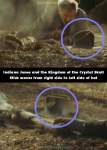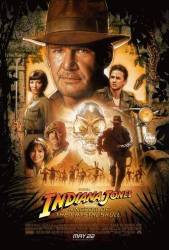
Continuity mistake: During the ants scene, Indy is about to grab a stick to the left of his hat. In the close-up the stick and the hat have swapped sides.
Continuity mistake: While Mutt's bike is sliding along the library floor, right before it comes to a stop it's pushing a chair on the right. A frame later the chair has magically made a 180º turn and moved half a meter to the right.
Continuity mistake: When Col. Spalko begins cutting the leather covering the alien corpse in the casket, no straps are seen. In the close-up shot a strap is suddenly visible.
Continuity mistake: In the race between the soldiers and the youngsters in the roadsters, there is a shot of boots on the military vehicle's pedals and the next shot is of sneakers on the same pedals.






Answer: Yep, you've forgotten some details. The Knight specifically states that the immortality bestowed by the Grail is limited to those who remain within the shrine. Jones Snr left the cave, ergo, no immortality.
Tailkinker ★